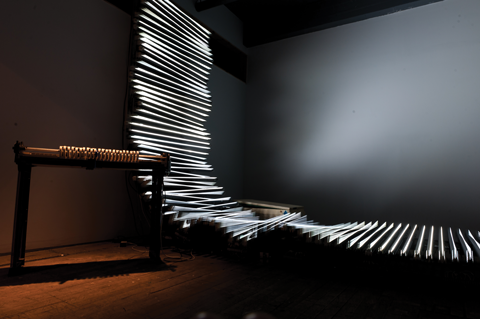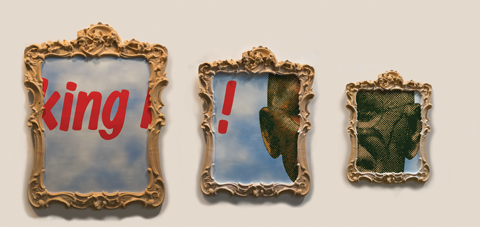I have been in a lot of other people’s basements in the course of my professional life, but never have I received so many unnecessary apologies while being led down flights of stairs.
I am used to basements. Many artists who are not international celebrities convert the subterranean rooms of their houses into studio space. Others renovate the garage or take over the extra bedroom, and some find one of the scarce affordable spaces available for rent in commercial buildings or the few artists’ co-ops. I made 62 studio visits during the process of selecting artists to show in the 2013 Alberta Biennial, and more as follow-ups. This is a large number. The carrot is that you can never be certain what you will find.
The first steps of curating the biennial went like this. The Art Gallery of Alberta, in Edmonton, issued to the province’s artists an open call for submissions. (The gallery co-founded the biennial in 1996, but its partner in this Edmonton/Calgary alliance, the Glenbow Museum, pulled out years ago.) Artists from all over Alberta—164 of them—answered the call. The gallery then sent the submissions, which included artist statements, Power Point presentations or slides, and CVs, to Calgary for me to review. Based on these files, I chose whose studios to visit and added a handful more.
The studio visit is a time-honoured and, I would say, privileged way for curators to see new art before it leaves the artist’s working space and appears in public. “The studio visit became a trope in modernism, and remains so,” wrote art critic and novelist Brian O’Doherty (who is also the artist known as Patrick Ireland) in his book Studio and Cube. “The visit has its etiquette and comic misunderstandings. The studio visitor is the preface to the public gaze. The visitor brings an environmental aura—collector, gallery, critic, museum, magazine. The studio visit can be a raging success or a disaster, a much desired ‘discovery’ or an intrusion from hell.”
During the studio-visit phase of the project, I tried not to be the intruder from hell, while I brought with me the “environmental auras” of museum, magazine and critic from my work as an art critic, curator and art magazine writer, both in print and online. Moreover, I was visiting as a guest curator from the Art Gallery of Alberta—my errand to make an exhibition that would be important to the artists who wound up in it, and to how they were perceived inside and outside the province.
An ideal studio visit presents an occasion for artists and curators to talk, get to know each other a little, swap ideas, ask questions (on both sides) and look together at art that might even still be in progress. This is probably my favourite part of the process. I learn from artists and from being in the spaces where they think about and make their work. I knew some of the artists who submitted to the biennial, but had never heard of or never met others. I travelled to Banff, Lethbridge, Grande Prairie and Edmonton. At home in Calgary, in addition to work by local artists, I saw one piece each by an artist from Black Diamond and one from Fort McMurray, both of which are in the show.
Visiting 62 studios between March and June 2012 was a challenge, but it was rewarding and fuelled by a sense of discovery that was often exciting enough for me to feel pumped. After this came choosing who was in and who wasn’t, decisions that really were difficult to make when it came down to the hairsplitting elimination round.

Wave Interference, by Robyn Moody, Calgary. (Courtesy of J. Guzzo Desforges)
Why does a curator choose one artist or work over another? This is the hardest part of the process to talk about in the abstract. I can say that it is based on knowledge, the experience of looking at a lot of art, and that subjective faculty known as taste, as well as other considerations. About three-quarters of the way through the studio visits, I noticed I was seeing references in contemporary work to Alberta’s physical, social, political and cultural geography to a degree I had not seen before. I started thinking about what that might mean. I thought back to the late 1970s, when I first moved to Alberta, and the debates going on then around the subject of Regionalism. I realized I had the opportunity to make a biennial with an unusually focused theme.
So some of my decisions were coloured by how well a work fit into the thematic construction of the show, which I started to shape once the studio visits were completed. The theme came out of the work. Put most simply, Regionalism and the old centre/periphery model of how ideas are disseminated in the art world have become obsolete in the age of economic globalization. In the work of contemporary Alberta artists, we see artmaking that goes beyond Regionalism. Call it Post-regionalism, if you like. I use the term for want of a better one. Although it may seem counterintuitive, my evidence for this shift is the artists’ renewed attention to, acceptance of and commitment to place.
Shifting the discourse of Regionalism to that of place—defined by human geographers as a meaningful location constructed by people and their practices—changes the subject position of the artist. This shift is “The News From Here,” as the title of the 2013 Alberta Biennial of Contemporary Art suggests. This eighth—and with 32 artists and collaborations, largest—biennial points outward and inward at the same time. The old Regionalism was a discourse imposed from the outside, from the centre to the hinterland, which necessarily was made to feel subordinate and inferior. Perceived dialogues, often in the guise of visiting artists and critics, went in one direction only, and folks in the hinterland were always running to catch up. In the 1970s many artists based in Alberta felt isolated, unrecognized and envious; many yearned to be elsewhere.
I wanted an exhibition important to the artists in it, and how they were perceived inside and outside Alberta.
Things are very different now. Artists here seem to feel a sense of identity connected to the specificities and textures of the daily, lived experience of a particular place. At the same time, they maintain practices that mirror place, produce innovative ideas and partake of the issues, ideas and technologies of international contemporary art, which they feel free to adapt, alter or counter within the context of a locale. In my essay in the catalogue of “The News From Here,” I take the position that place is a significant factor in the making of art, and that art is a significant factor in the shaping of place. Our art reflects who we are and want to be, and what we think and feel about how and where we live. It is a means by which we create and perpetuate our myths, at the same time that it strips away the image of provincialism. Influences these days flow from many directions. It is possible for artists to be “in place” and also to get some distance, the longer view.
Artists in 2013 Alberta show their work locally, nationally and internationally. One thing I discovered is how busy these people are. Connected to the Internet and social media, they are also cosmopolitans who travel widely, network, study abroad and attend international residencies, which today are offered in some 70 countries around the world. Some works in the biennial were conceived or worked out in artist residencies in places as different and far-flung as Colombia and Lebanon, yet remain deeply immersed in this place. Terrance Houle, for example, wrote the proposal for his short film Isstahpikssi (eestah-peek-see)—Ghost (2013) during a residency in Bogotá. The protagonist of the film, which is based on the French experimental filmmaker Chris Marker’s La Jetée (1962), is his Blackfoot ancestor Isstahpikssi, who becomes a time traveller via the alchemical vehicles of photography and film. His name means ghost. Houle, who develops his narrative using old family photographs among other image sources, makes of Isstahpikssi a witness to the history of relations between Aboriginal peoples and Europeans.
The biennial has become a popular exhibition format—there are 200 now held around the globe—whose job is to update its audience on what is going on in contemporary art, internationally or in a locale. Even before I started looking at work, I decided to stick to the biennial format and choose art made in the previous two years. This was not always strictly possible, but I came close. I decided not to include artists who had appeared in the 2010 edition, to make more space for unknown artists, and I came close. Jason de Haan, who collaborates here with Miruna Dragan, was in the last Alberta Biennial, “Timeland,” in 2010.
“The News From Here” is an exhibition of new and recent work in painting, sculpture that bends traditional categories, photography, video, performance, film and live cinema, a type of multimedia performance that includes image projections, voice and improvised music. This biennial includes a fair amount of moving-image art and a film program. I wanted the show to be fresh and to have the potential to surprise and illuminate through the works and their juxtapositions. (My other favourite part of exhibition-making is installing the show, shaping the visual and physical entity of the exhibition itself.) Several artists, including Faye HeavyShield, Laura Vickerson, DaveandJenn, Pamela Norrish, Chris Cran, Eric Moschopedis and Mia Rushton, and Houle, agreed to make new work for the show.

king! by Chris Cran, RCA, Calgary. (Courtesy of Chris, Cran, Trepnaier Baer Gallery, and Clint Roenisch Gallery)
When word got around that I had been invited to curate the 2013 biennial, people I ran into frequently posed a rhetorical question: “You’re doing this all by yourself?” My guess is that by asking a question that was really a comment, they were acknowledging two things: that curating a biennial is a big job, and that it is a big responsibility not to be taken lightly. The Alberta Biennial is an important exhibition. I did see the work of several artists I would have included but couldn’t because there was not enough space. (My first thought upon waking many mornings during the selection process was, will they all fit?) But as it is, I asked for and graciously was given more space than the Art Gallery of Alberta has ever devoted to a biennial before. Works in “The News From Here,” the second biennial to appear in architect Randall Stout’s award-winning gallery, can be found in the gallery’s facade, in Manning Hall and the special collections gallery on the first floor as well as the entire third-floor gallery and on the third-floor terrace.
That there was more good art than I could find a place for reflects the quality of work by Alberta-based artists. My eyes have always been bigger than the available gallery space. And, should it need to be said, I did not curate the biennial by myself. I undertook it with the support and consultation of Catherine Crowston, AGA executive director and chief curator, who let me run with my ideas, and her consummately professional staff. I kept waiting for someone to say no to a request, but no one shrank from things that might be a little out of the ordinary or difficult, such as craning a 7,000 lb., fully functional “tiny house”—The Cardiff-Miller House, by Emily Luce—up to the terrace on the third floor. What more could anyone ask?
Nancy Tousley was art critic for the Calgary Herald for more than 30 years. She received the 2011 Governor General’s Outstanding Contribution Award in visual and media arts.

